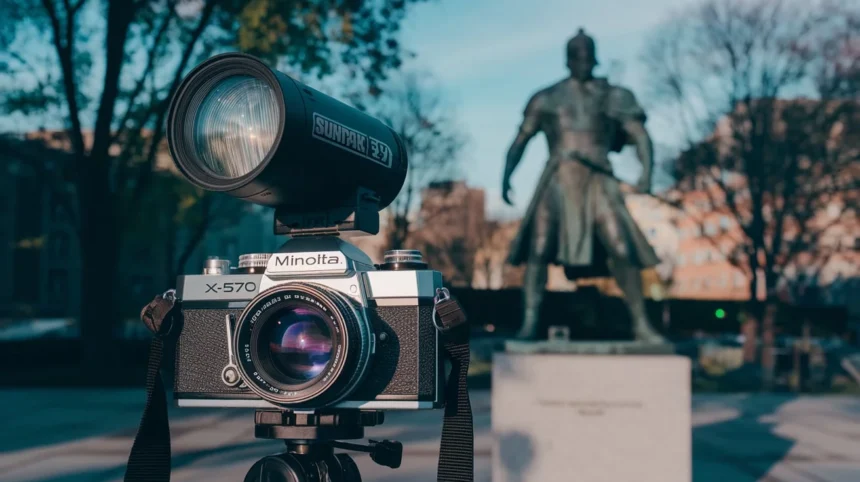Introduction to How to Sue Flash in Minolta XGA
Are you an amateur photographer grappling with flash problems on your trusty Minolta XGA? You’re not alone. Many enthusiasts find themselves lost in the settings, wishing for a little guidance to help illuminate their shots. Whether it’s that perfect portrait or capturing candid moments, mastering how to sue flash in Minolta XGA can make all the difference. This guide will walk you through everything you need to know about using flash effectively with your camera, ensuring you’re ready to take stunning photographs every time you press that shutter button. Let’s dive into the world of photography and shed some light on those pesky flash issues!
Understanding the Minolta XGA Camera
The Minolta XGA is a unique gem in the world of photography. Known for its compact design and user-friendly interface, this camera appeals to both beginners and seasoned photographers alike.
With its advanced features, the XGA allows users to explore various photographic styles. It boasts an impressive sensor that captures vibrant colors and sharp details, making every shot memorable.
One standout feature is its built-in flash system, which can be a game-changer during low-light situations. Understanding how it operates will enhance your shooting experience significantly.
Moreover, the camera supports manual adjustments for exposure and focus. This flexibility encourages creativity while helping users learn essential photography techniques over time.
Getting accustomed to the Minolta XGA’s functionality opens up new creative pathways, allowing you to capture moments like never before. Dive into your photographic journey with this remarkable tool at hand!
Troubleshooting Common Flash Issues
Flash issues can be frustrating, especially when you’re eager to capture the perfect moment. One common problem is the flash not firing at all. First, check if it’s turned on and ensure that your camera settings allow for flash usage.
Another issue might be inconsistent brightness in your photos. This could stem from incorrect exposure settings or even a dirty lens. Cleaning your lens regularly can help maintain optimal image quality.
Sometimes, you may notice shadows appearing in your shots. This often happens due to harsh lighting conditions or being too close to your subject. Adjusting the distance between you and the subject can soften those shadows significantly.
Battery life plays a crucial role as well. If flashes seem weak or fail altogether, consider changing or recharging batteries before diving into more complex fixes. Keeping spare batteries handy ensures you’re always ready to shoot without interruptions.
Step-by-Step Guide on How to Sue Flash in Minolta XGA
To sue flash in Minolta XGA, start by checking the camera settings. Navigate to the menu and ensure that the flash is enabled.
Next, examine the physical condition of your flash unit. Look for any signs of damage or loose connections.
Once confirmed, adjust your exposure settings. A higher ISO can help if you’re shooting in low light without relying solely on flash.
Now, experiment with different modes. The “Auto” mode often provides optimal results across various conditions.
If issues persist, reset your camera’s settings to factory defaults. This step can resolve glitches affecting performance.
Test again by taking a few shots in diverse lighting scenarios. This process will give you a clearer understanding of how to maximize your flash capabilities effectively.
Tips and Tricks for Capturing the Perfect Shot
Lighting can make or break your shot. Experiment with natural light, especially during golden hours—early morning or late afternoon. Soft diffused lighting enhances details beautifully.
Composition is key. Use the rule of thirds to create a balanced frame. Position focal points along the gridlines for added interest.
Don’t shy away from getting creative with angles. Shoot from above or below to provide fresh perspectives that captivate viewers.
Focus on your subject’s eyes when capturing portraits; they draw people in and convey emotions effectively.
Consider using manual settings on your Minolta XGA for complete control over exposure and aperture. Adjusting these settings helps achieve the desired depth of field.
Practice patience. Wait for that perfect moment where everything aligns—a fleeting expression, an intriguing shadow, or a burst of action can elevate any photo significantly.
Alternatives to Using Flash in Photography
Natural light is a photographer’s best friend. It often creates beautiful, soft shadows and highlights that can enhance your subject’s features. Consider shooting during golden hour when the sun casts a warm glow.
Reflectors are another great tool for manipulating light. They bounce sunlight onto your subject, filling in shadows without harshness. You can easily create one using white cardboard or specialized photography reflectors.
Experimenting with higher ISO settings allows you to capture images in low-light conditions without flash interference. Just be mindful of potential graininess; balance is key.
Softbox lighting provides an alternative in controlled environments. This diffused light source mimics natural light while eliminating strong contrasts.
Embracing longer exposure times can yield stunning results at night or in dimly lit spaces, allowing ambient lights to shine through beautifully without the use of flash.
Conclusion: How to Sue Flash in Minolta XGA
Mastering how to sue flash in Minolta XGA opens up a world of creative possibilities. With practice, patience, and the right techniques, you can elevate your photography game.
Understanding your camera’s settings is crucial. Familiarizing yourself with options allows for better control over lighting conditions. Experimentation will lead you to discover what works best for different scenarios.
Don’t shy away from natural light either. It can beautifully complement or replace artificial flash when needed. Learning to balance both sources enhances your skills as a photographer.
As you delve deeper into using the flash effectively, enjoy the journey of capturing stunning images that tell stories through light and shadow. Embrace each shot as an opportunity to learn and grow in this art form. Your unique perspective awaits discovery with every click of the shutter!
FAQs
Understanding how to sue flash in Minolta XGA can be a bit overwhelming, especially for amateur photographers. Here are some frequently asked questions that might clear up any lingering doubts.
Q: What does it mean to “sue” the flash?
A: To “sue” the flash typically refers to fixing or modifying your camera’s flash settings or functionality. This may include troubleshooting issues related to exposure and syncing problems with your shots.
Q: Can I use an external flash with my Minolta XGA?
A: Yes, you can use an external flash if your camera supports it. Just ensure that you have the correct connection and settings adjusted on both devices for optimal performance.
Q: Why is my Minolta XGA not firing the flash?
A: Several reasons could cause this issue: low battery power, incorrect settings, or dirty contacts between the camera and the flash unit. It’s essential first to check these factors before seeking further solutions.
Q: Are there other lighting options besides using a built-in flash?
A: Absolutely! You can experiment with natural light by shooting during golden hours or consider using reflectors and diffusers for softer light effects without relying solely on flashes.
Q: How do I know if my photos need more light than what’s available?
A: If you’re getting dark images even when adjusting ISO settings or aperture properly, it’s likely you need additional lighting assistance from either built-in flashes or external sources.
Q: When should I avoid using a flash altogether?
A: In situations where ambient light creates beautiful shadows—like portraits outdoors—or when reflective surfaces could create harsh highlights, it’s better to skip the use of a flashlight entirely.
These FAQs aim to provide clarity while navigating through photo opportunities with your Minolta XGA. With practice and experimentation, you’ll soon master capturing stunning photographs under various lighting conditions.








